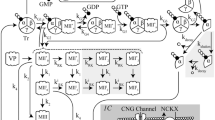Abstract
The light-induced hyperpolarization of the photoreceptor results in a decrease in extracellular potassium ion concentration, [K+]∘. A decrease in [K+]∘ in the photoreceptor layer was caused by injecting a small amount of K+ -free Ringer's solution in the isolated frog retina, and the distribution of the field potential as induced by K+ -free Ringer's solution was mapped. The depth profile of the response resembled that of the slow PIII component of the electroretinogram. These results support the notion that the slow PIII is generated by the Müller cells as they hyperpolarize in response to a light-induced decrease in [K+]∘ in the photoreceptor layer.
Similar content being viewed by others
References
Oakley BII, Green DG. Correlation of light-induced changes in retinal extracellular potassium concentration with c-wave of the electroretinogram. J. Neurophysiol 1976; 39: 1117–33.
Faber DS. Analysis of the slow transretinal potentials in response to light [Ph. D. Thesis]. State University of New York at Buffalo, 1969.
Witkovsky P, Dudek FE, Ripps H. Slow PIII component of the carp electroretinogram. J Gen Physiol 1975; 65: 119–34.
Fujimoto M, Tomita T. Field potentials induced by injection of potassium ion into the frog retina: A test of current interpretations of the electroretinographic (ERG) b-wave. Brain Res 1981; 204:51–64.
Yanagida T, Tomita T. Local potassium concentration changes in the retina and the electroretinographic (ERG) b-wave. Brain Res 1982; 237:479–83.
Yanagida T, Tomita T. Asymmetrical potassium permeability of the Müller cell: Field potential induced by intraretinal injection of K+ -free Ringer's in the frog retina. Jpn J Ophthalmol 1984; 28:215–21.
Matsuura T, Miller WH, Tomita T. Cone-specific c-wave in the turtle retina. Vision Res 1978; 18:767–75.
Fujimoto M, Tomita T. Reconstruction of the slow PIII from the rod potential. Invest Ophthalmol Vis Sci 1979; 18:1090–93.
Author information
Authors and Affiliations
Rights and permissions
About this article
Cite this article
Yanagida, T. Simulation of the electroretinographic slow PIII component by injection of K+ -free Ringer's solution in the frog retina. Doc Ophthalmol 76, 395–400 (1991). https://doi.org/10.1007/BF00142678
Accepted:
Issue Date:
DOI: https://doi.org/10.1007/BF00142678




